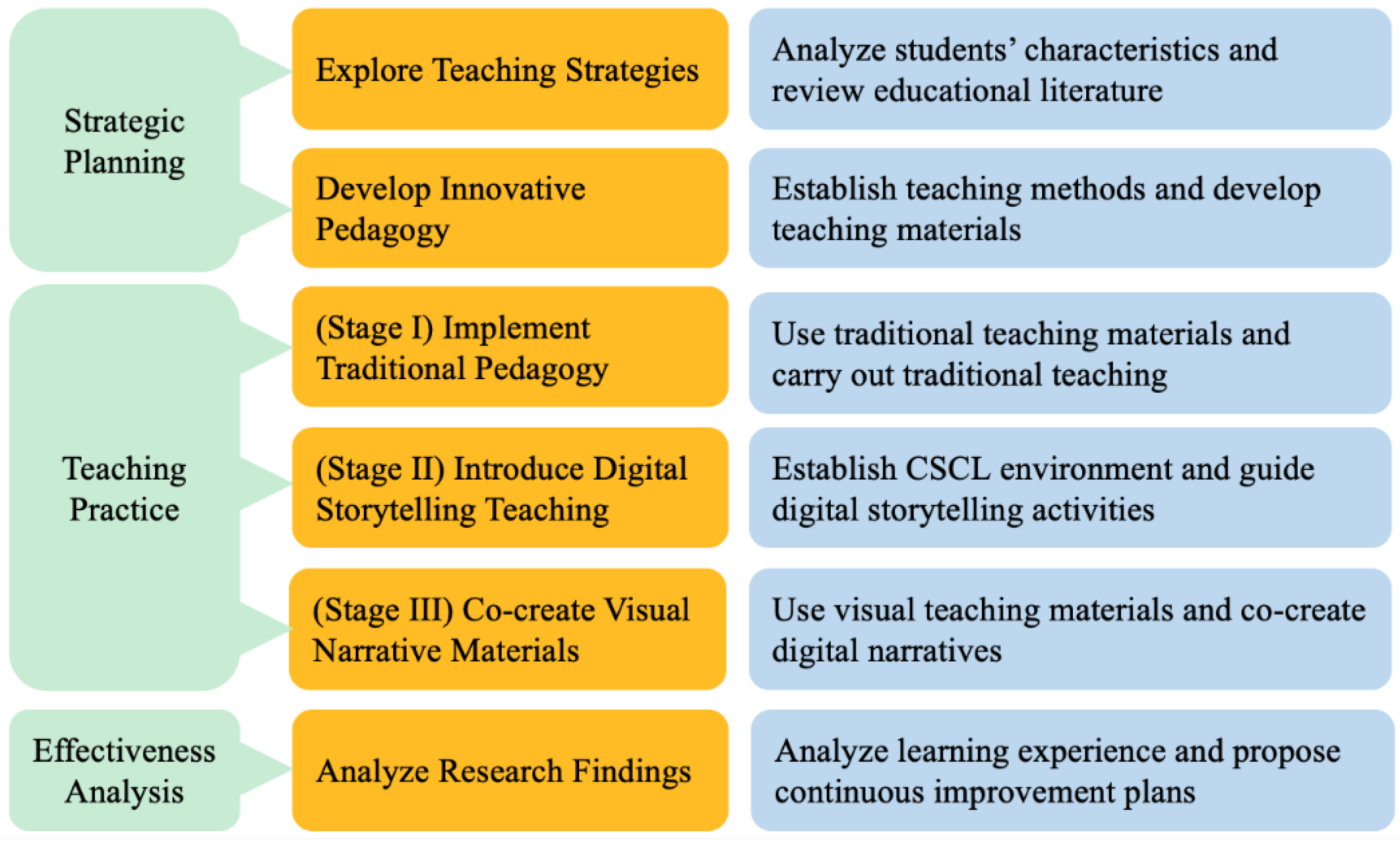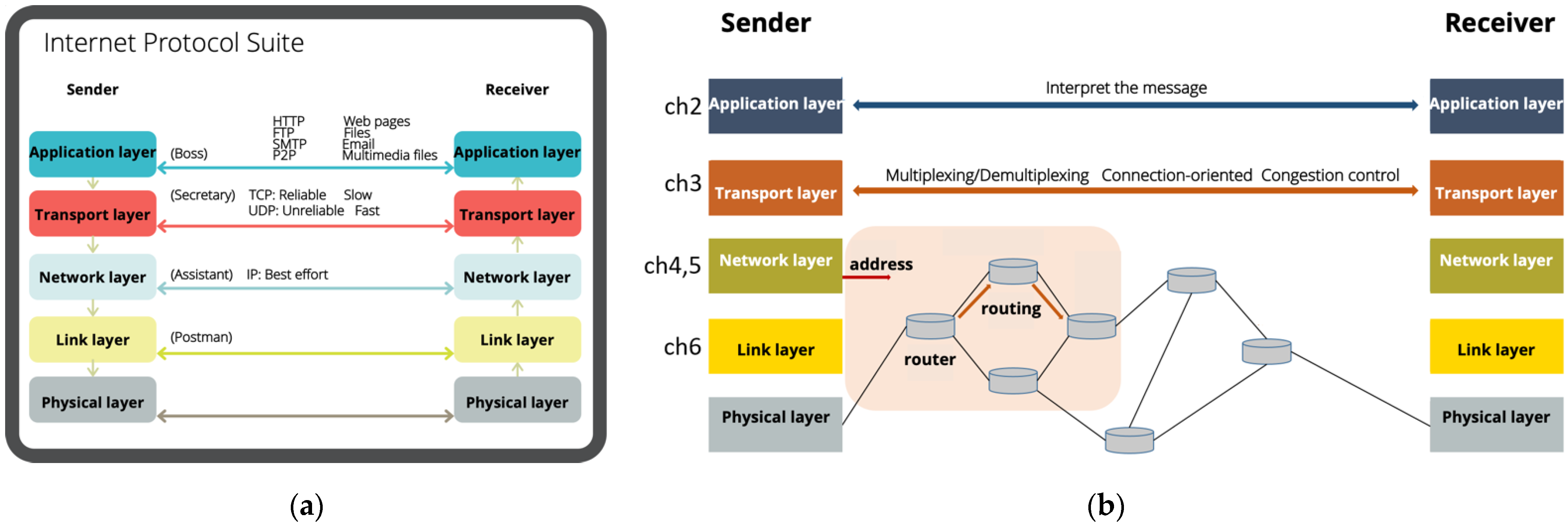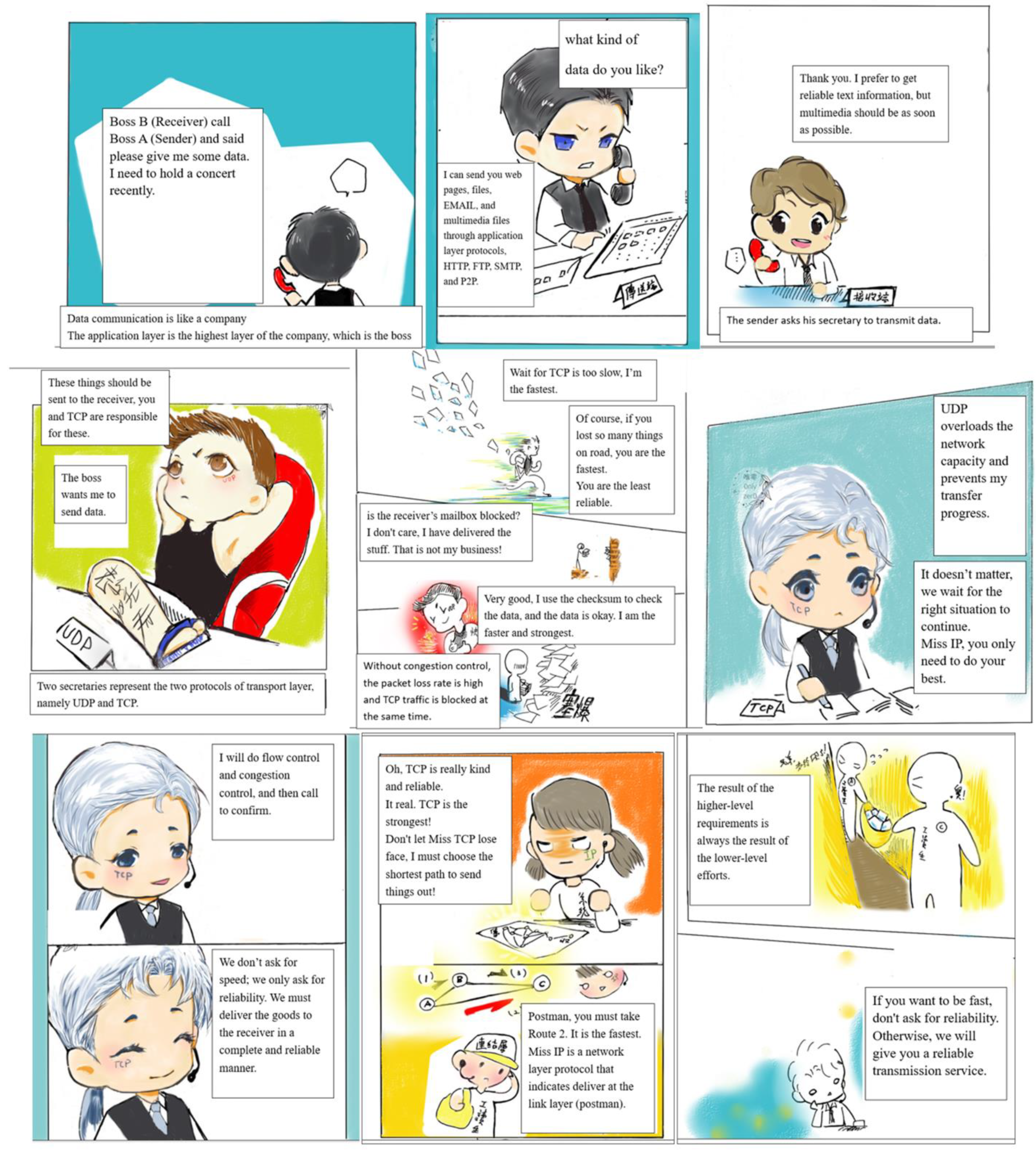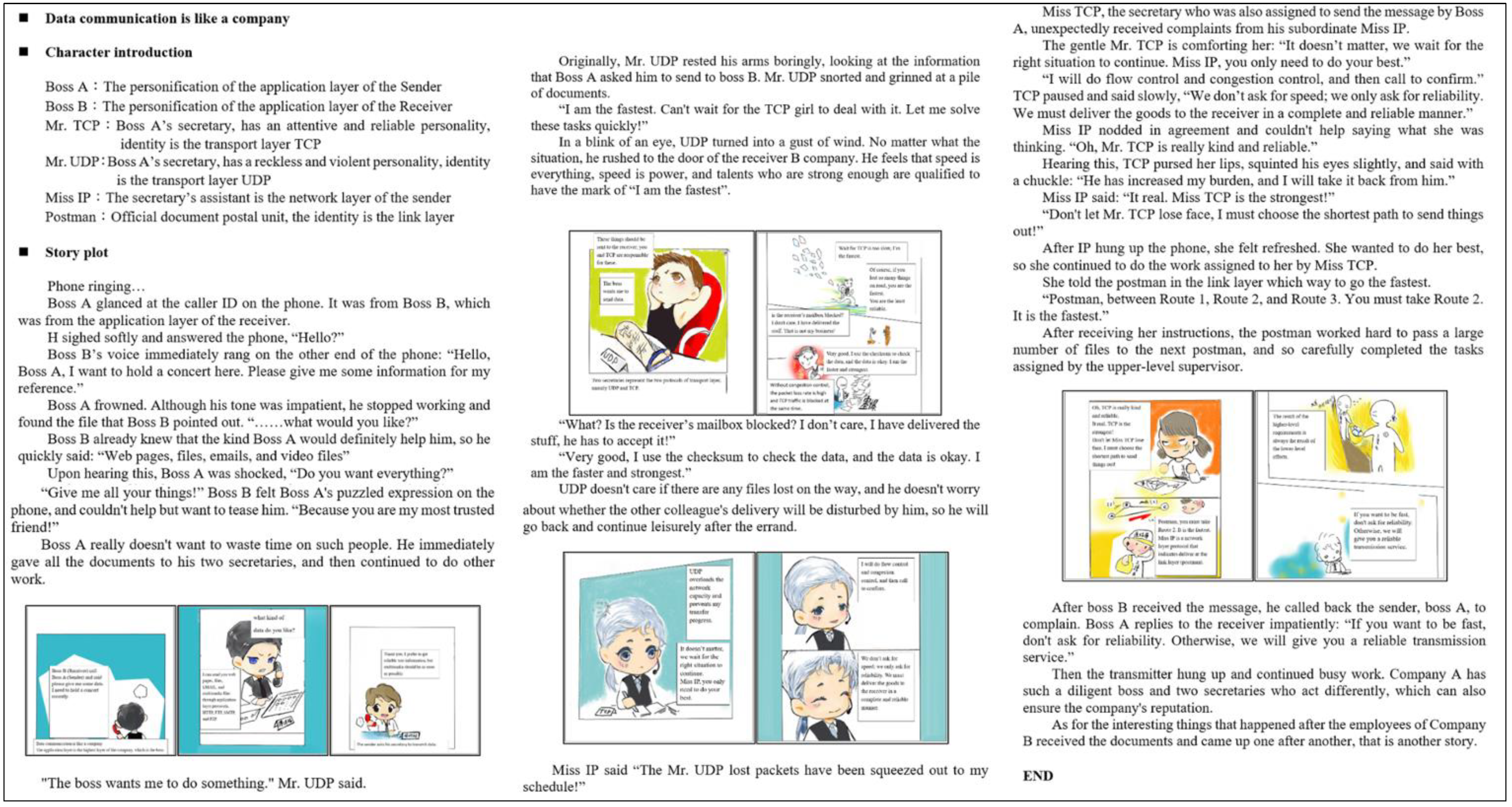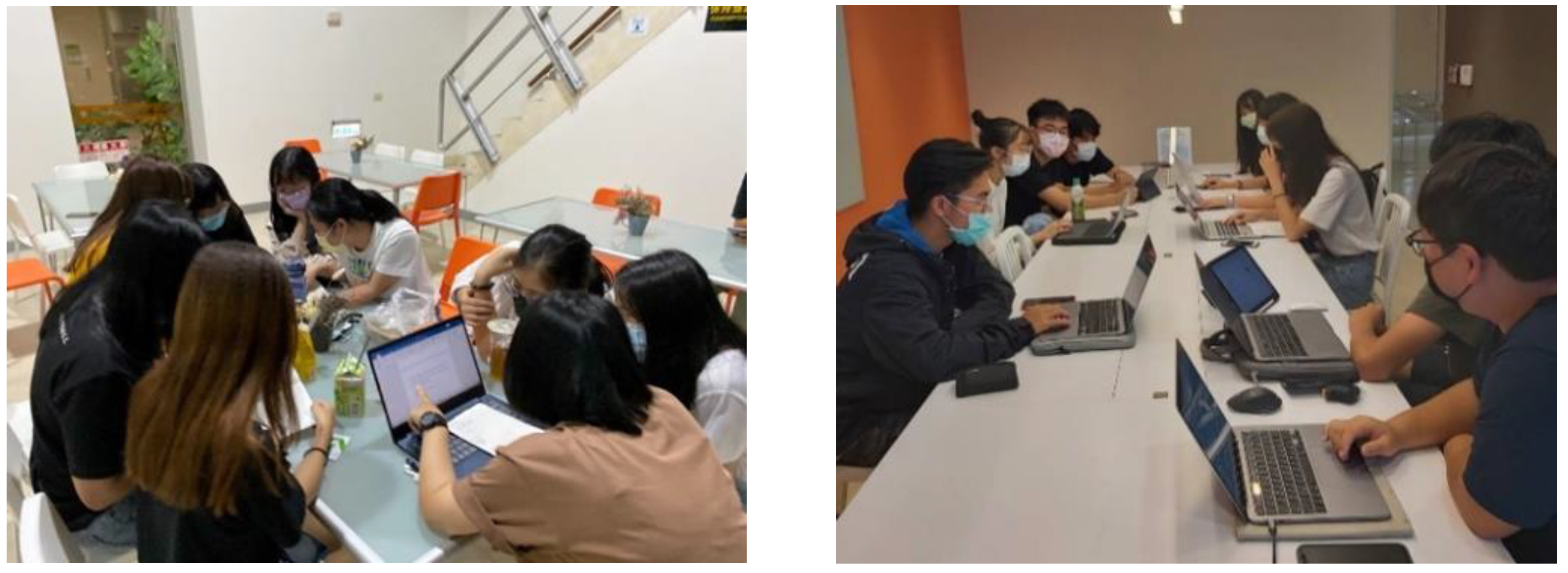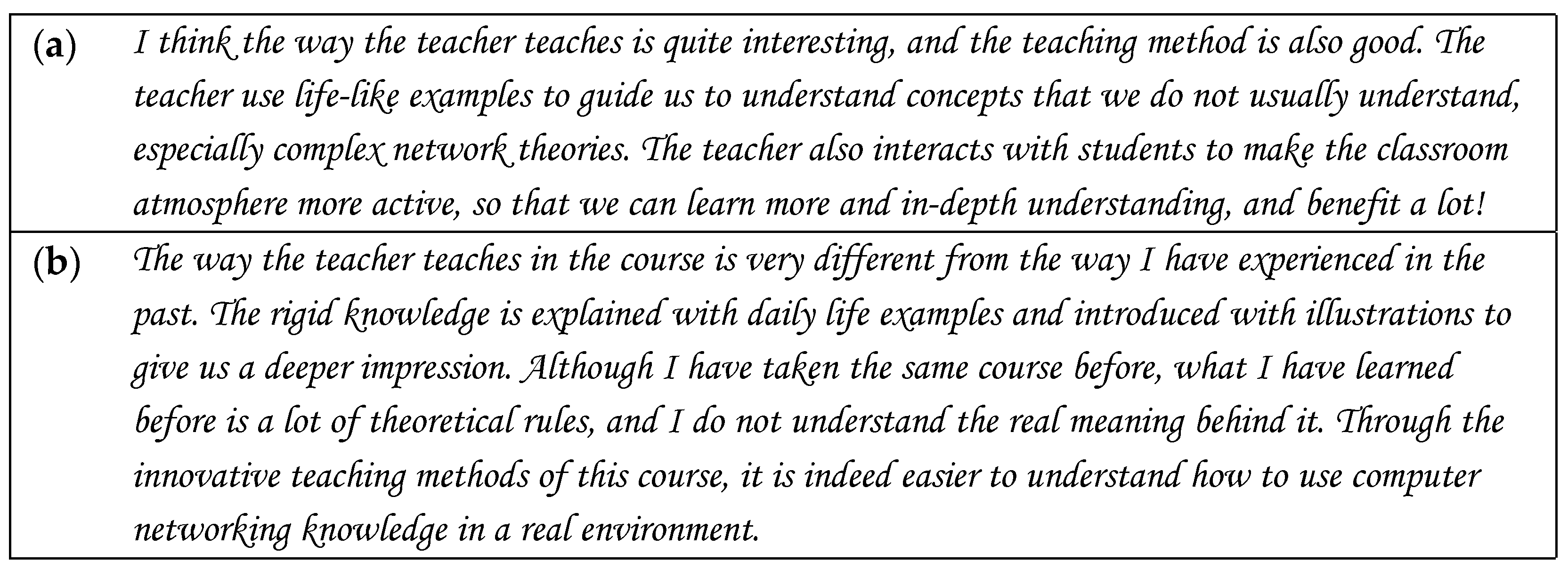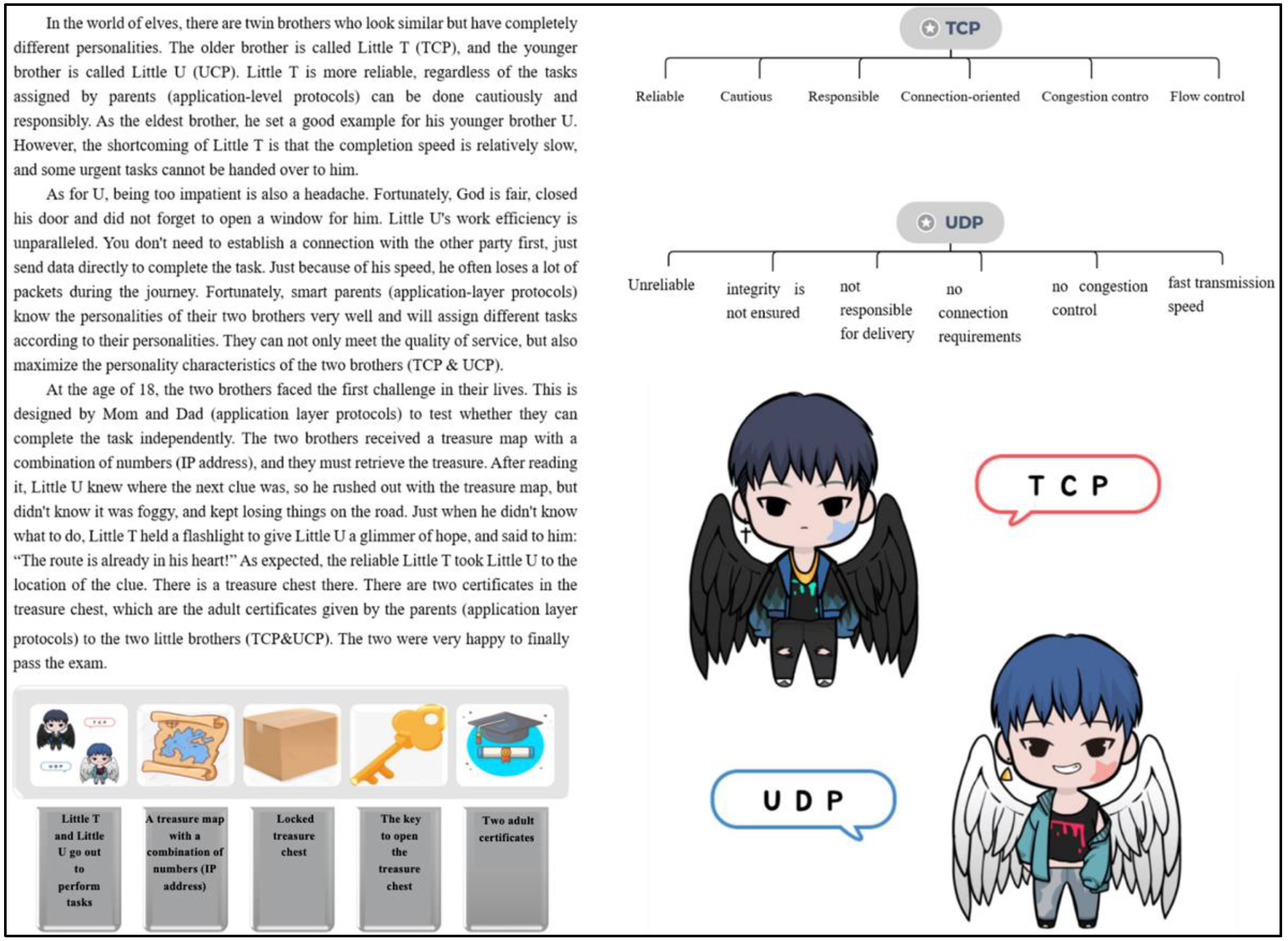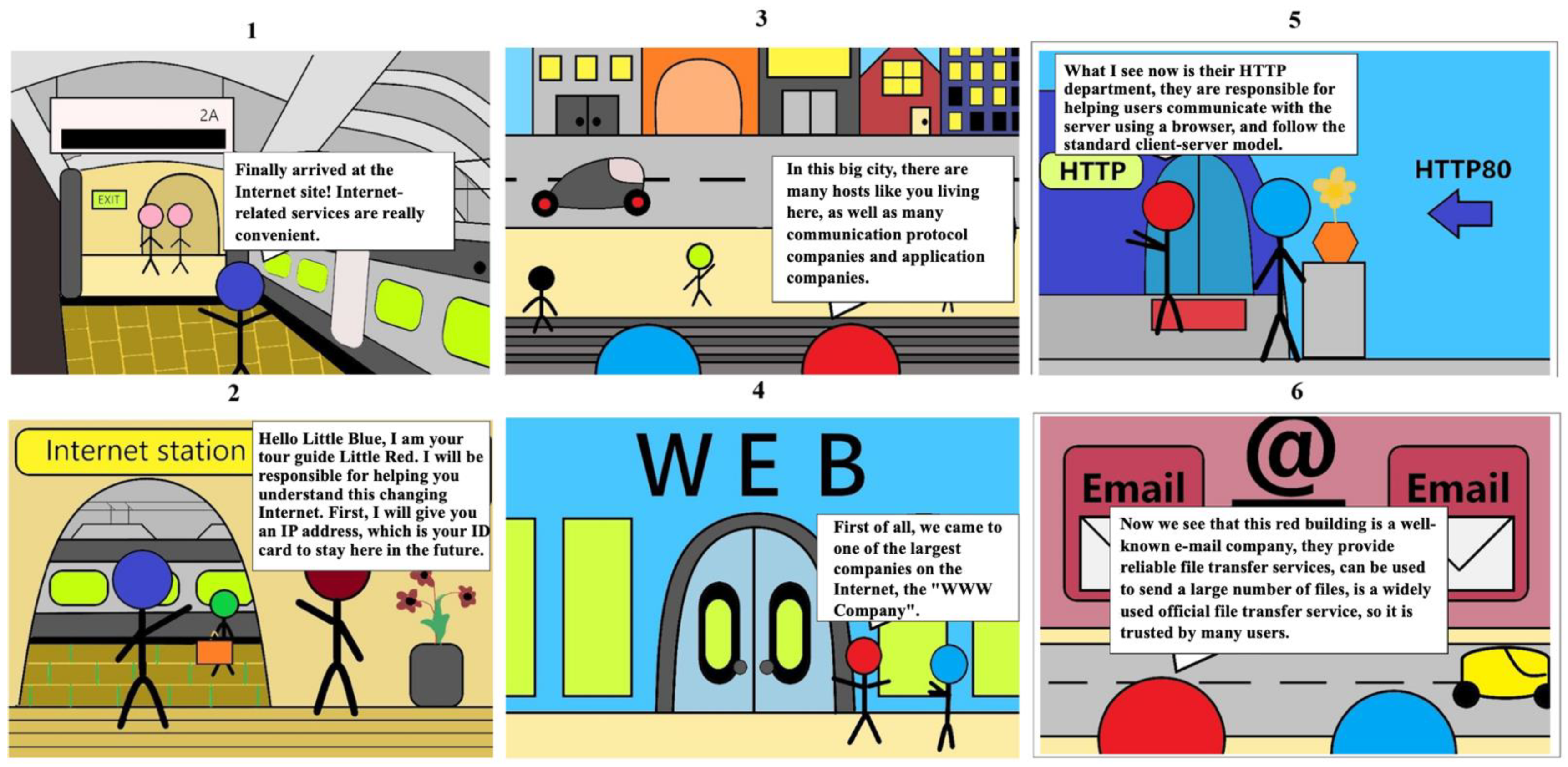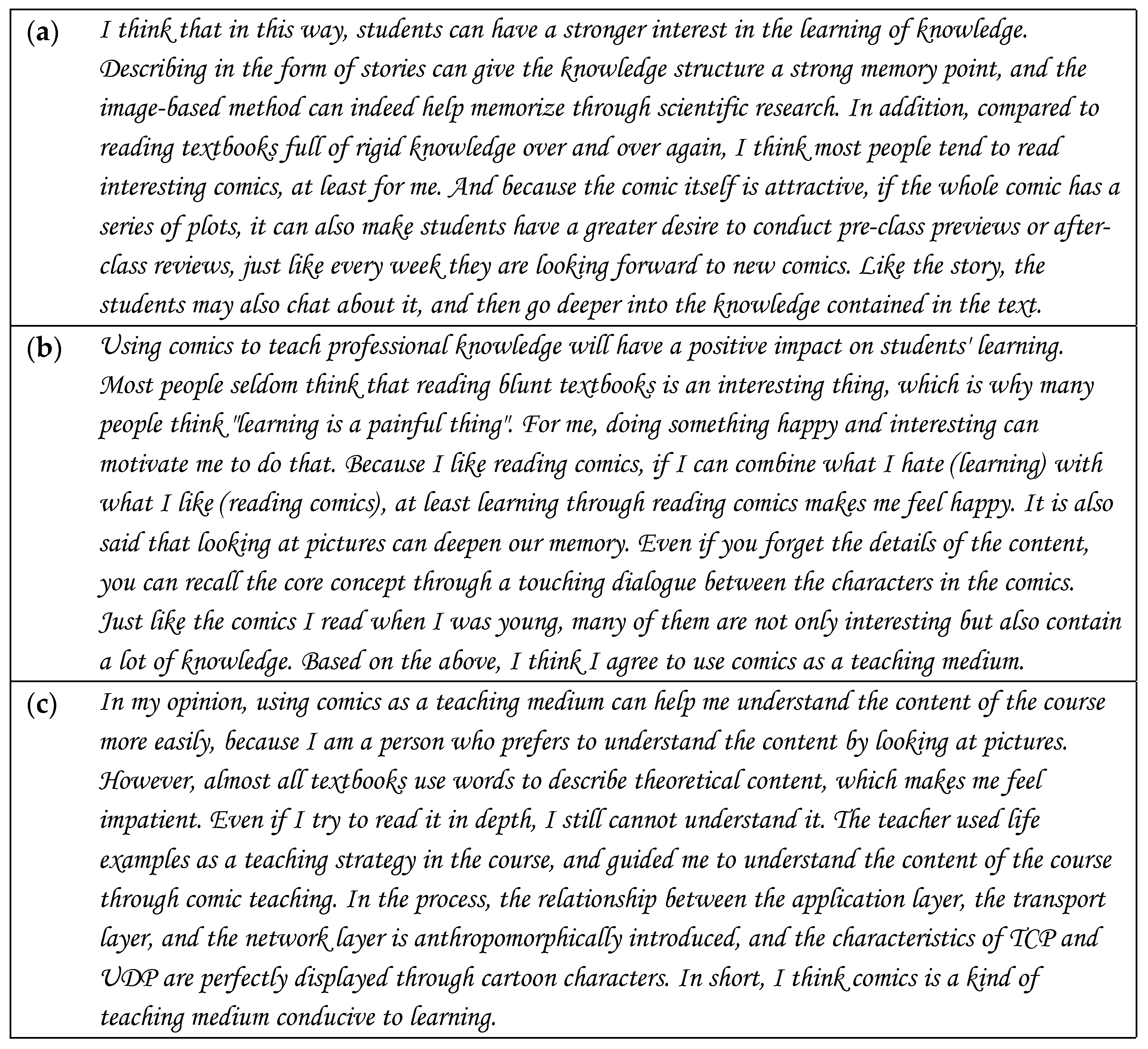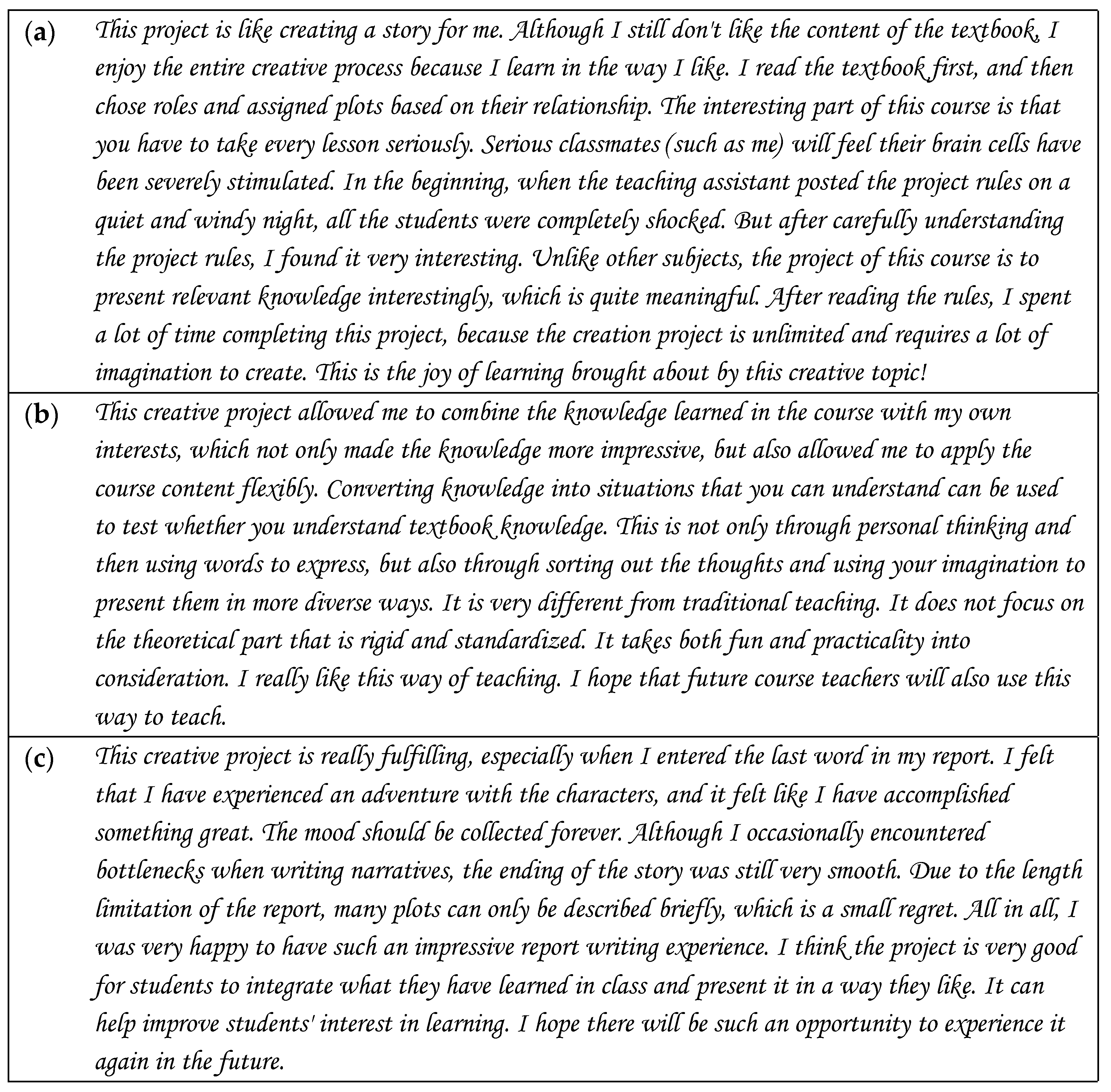1. Introduction
With the popularization of the Internet and digital technology, the learning preferences of contemporary students are different from those of the past. The current Generation Z students have the characteristics of active learning and visual gamers and like to build learning plans through self-like and task-oriented motivation [
1]. Traditional teaching methods often make it difficult for Generation Z students to learn professional courses. Therefore, to arouse the active learning interest of Generation Z students, it is necessary to make good use of the students’ learning-by-doing learning method and create communities of practice in the teaching design environment [
2]. By constructing a learning environment based on social learning theory can we continue to stimulate the enthusiasm for game-based learning through community interaction and successfully learn professional knowledge [
3].
In terms of innovation in teaching materials, the use of visualization technology to provide theoretical knowledge, along with powerful tools for exploring knowledge and giving meaning, can reduce the burden of information processing and help students understand and remember the theoretical basis of their learning [
4]. Digital narrative teaching techniques can deepen students’ knowledge reasoning and causality, thus attracting their attention [
5]. Experiments have proved that when the topic of communication networking is introduced in the context of the story, students concentrate on the meaning given to the topic. Therefore, students have enhanced motivation to use the theoretical knowledge they have learned to solve practical computer networking issues [
6].
In terms of innovation in curriculum activities, the importance of group cooperation in digital narration is to enhance learning motivation. In addition to passive learning in class, students must create digital stories with team members after class [
7]. Digital storytelling techniques are considered powerful learning tools that can make teaching and learning processes more effective, meaningful, interesting, and creative [
8]. According to previous research [
9], digital narrative activities can create more interesting and enjoyable learning environments, and encourage students to establish a connection between learning and daily life. Scholars Dogan and Robin [
10] believe that digital narrative is a teaching skill that supports learning, encourages collaboration, develops decision-making processes, and enables students to change from a negative learning style to a positive learning attitude. Therefore, the digital narrative is considered an important learning method in the modern learning environment because it supports collaboration and the development of creative thinking, enabling students to check their learning understanding and effectiveness [
11].
This research proposes a three-stage progressive teaching method for a university computer network course. The proposed method gradually uses traditional instruction, digital storytelling teaching methods, and visual narrative creation projects to help students understand the logical concepts of computer networking theory. This research transforms the content of the course from theoretical and conceptual descriptions into story plots of computational thinking. Furthermore, this study also introduces innovative visual narrative creation projects, allowing students to use digital narrative methods for practical exercises. The objective of this research is to develop students’ logical reasoning concepts through anthropomorphic characters and story plots to increase students’ understanding and learning interest in the content taught. This kind of processing of knowledge theory into a digital narrative is a new challenge for students that can enhance the learning motivation of Generation Z students, thereby improving their learning effect.
The results of this research show that the use of the digital storytelling teaching method improves students’ learning comprehension, while group creative activities that introduce visual narratives enhance the students’ joy of learning. The use of situational narrative teaching methods to teach, interact, evaluate, and motivate the teaching of such computer network courses makes it possible for students to learn professional knowledge and create value, thus enhancing their learning effectiveness and problem-solving ability.
The remaining parts are organized as follows.
Section 2 provides a background on computational thinking, computer-supported collaborative learning, and digital narratives.
Section 3 provides the research methods, program design, the proposed teaching method, innovative materials, and evaluation design used to conduct this research.
Section 4 demonstrates the learning results and learner feedback.
Section 5 concludes the work and provides research contributions.
2. Background
The current generation of university students born between 1995 and 2010 is referred to as Generation Z. They grew up in an era of the rapid development of the Internet; they also experienced the rise of mobile devices and cloud computing. They are adept at using various digital technologies to access information quickly; as a result, their learning characteristics tend toward real-time query, visual learning, and learning by doing [
1]. To successfully establish a community of practice, it is necessary to encourage students to participate in group activities, gradually increase their depth of learning and understanding, and thereby increase their enjoyment of the learning process [
12]. Therefore, this research encourages students to form teams and become core members of the communities of practice. Solve problems together through practice to improve learning motivation and effectiveness.
2.1. Teaching Methods of Computational Thinking
Computational thinking uses the logical thinking of computer science to design processes, understand behavior, and solve problems [
13]. According to Psycharis [
14], computational thinking may include the ability to abstract, decompose, reason, optimize, reuse, and share knowledge of computer science concepts. Bundy [
15] pointed out that computational thinking ability is an indispensable ability in the learning and understanding of all disciplines. Only by using computational thinking to understand the content and analyze logical relationships can problems be solved.
Therefore, this research introduces how to implement computational thinking in teaching activities to help students develop the computational thinking ability to understand the knowledge of computer networking. The concept is abstracted, modularized, and decomposed into small functions; then, the causal relationship and the optimization issues are found through reasoning; thereby, the results can be applied to solve real-life problems; finally, in a creative project report, the situational narrative method is used to describe the observation and learned knowledge to enhance learning comprehension.
2.2. Computer-Supported Collaborative Learning
Johnson and Johnson [
16] pointed out that, compared to individual learning, students perform better in collaborative learning. Lazareva and Cruz-Martinez [
17] also stated that collaborative learning students outperform other types of learners and promote greater learning performance. The technology used for collaborative learning must provide learners with opportunities to participate in common tasks, effectively communicate, share resources, receive support for effective collaboration, participate in co-construction, standardize learning, and establish communities of practice [
18]. The technical role of computer-supported collaborative learning (CSCL) is not only to promote the communication and collaboration process but also to improve and facilitate the group learning process, helping participants to interact effectively [
19].
2.3. Teaching Environment of Digital Narratives
Kirchner [
20] claimed that stories are effective educational tools because they are convincing, easy to remember, and entertaining. Incorporating stories into teaching will help improve students’ understanding and memory of the content. Improving students’ levels of understanding also improves their motivation for learning and the effectiveness of their learning. Teachers develop digital storytelling according to the content of their courses. Digital storytelling has different effects when used at different times: (1) in the introduction of teaching activities, digital storytelling can be used to introduce courses, attract attention, and stimulate curiosity; (2) in the teaching activities, a digital narrative can prompt students to check their concepts and theories of the course content; and (3) in the after-class practice projects, a digital narrative can enhance students’ impression of course knowledge and become a driving force for their future learning [
9].
McLellan [
21] emphasized that because digital storytelling helps to improve creative writing and communication skills, it is widely used in higher education. Robin [
22] claimed that digital narrative not only enriches the imagination of students but also provides a valuable experience for them to create stories. Lisenbee and Ford [
23] stated that 21st-century skills (such as information literacy, visual literacy, media literacy) can be improved through the meaningful personal creation of digital narrative, which can cultivate digital picture creation, multimedia analysis, and knowledge expression skills. Sadik [
24] pointed out that digital narrative encourages students to think more deeply about their topic or story, helps them personalize their experience, and provides opportunities to showcase their knowledge of the topic.
Narrative pedagogy teaches theories in the form of stories and narratives. In the teaching environment, narrative pedagogy is increasingly being used because the narrative ability is not only a natural form of expression for people of any age and culture, but it also aids cognition and understanding [
25]. Dettori and Paiva [
26] found that narrative learning is considered helpful for student performance because the narrative process helps students to understand the experience, organize knowledge, and increase their learning motivation. Narrative pedagogy can give meaning to all knowledge points. When students understand knowledge and create stories, their attention will be focused, and because this learning method is challenging, it will give meaning to all cited knowledge theories, thus arousing curiosity and fantasy and increasing learning motivation. Students use narrative learning to inspire inspiration and active thinking, but also because narrative learning can cultivate narrative skills, enhance students’ understanding of knowledge theory, and improve memory. Therefore, the ability to solve problems is also improved, which is especially suitable for use in courses of theoretical knowledge content, such as data communication networks [
26].
3. Research Design and Teaching Methods
This research is aimed at the characteristics of Generation Z students and proposes the use of digital storytelling teaching methods with CSCL tools to support the teaching of computer networks, guiding students to conduct computational thinking through visual narrative creation projects. Based on the visual gamers and active learning characteristics of Generation Z students, using CSCL to assist teaching allows students to actively participate in discussion activities, digital storytelling, group communication, and online sharing of learning experiences. The course uses an online learning platform to assist teacher-student interaction outside of class time. We develop the learning methods required for scientific subject inquiry and critical thinking through relevant skills, such as online search, peer discussion, and source analysis [
27]. Therefore, students can use information and communications technology (ICT) to support their collaborative learning.
3.1. Method of the Research
The target course is computer networks, which content focuses on the operating principles of the Internet protocol stack to ensure the quality of services for data transmission. The participants in this study were 100 freshmen from the Department of Information Management in the College of Business.
This research explores pedagogical methods to improve learning motivation and effectiveness. Due to the complexity and exploratory nature of the research topic, this research adopts a mixed qualitative and quantitative research method design and pays more attention to qualitative research results. This design allows researchers to use different collections of works and feedback suggestions to confirm the results based on the comparison of teaching methods.
The qualitative research methods collect (1) students’ feedback, (2) the design work of graphic conceptual architecture, and (3) the visual narrative creation project. The quantitative research methods evaluate students’ academic performance by comparing the results of mid-term and final exams.
3.2. Design of the Program
This research focuses on freshmen in a computer network course. The purpose of this course is to train students to (1) clearly explain the basic concepts of computer networks and perform reasoning, (2) use good judgment to select tools to solve application issues, (3) apply different algorithms for solving networking tasks, and (4) set up networks. This course implements the proposed innovative teaching methods to enhance students’ learning enjoyment and understanding, thereby enhancing their learning effectiveness. To maximize the effectiveness of this research, this study analyzes the characteristics of the students, proposes innovative teaching practice plans, and analyzes the effectiveness of the teaching methods.
Figure 1 shows the design steps of this research, divided into three steps: (1) strategic planning, (2) teaching practice, and (3) effectiveness analysis. Each research design step is described in detail.
Step 1.1: Analyze students’ characteristics: Analyze the learning characteristics of Generation Z students, understand that students have the characteristics of active learning and visual gamers, and adopt learning-by-doing learning methods.
Step 1.2: Review educational literature: Based on existing literature, understand the characteristics of various innovative teaching methods. Thus, experimental learning and group-based learning are introduced to improve students’ understanding and stimulate their interest in learning.
Step 2.1: Establish teaching methods: Decide to use digital storytelling methods to enhance students’ comprehension and encourage students to jointly create visual narrative works to enhance learning motivation.
Step 2.2: Develop teaching materials: Design diversified teaching materials for each teaching stage to improve students’ understanding as to the basis for research amendments.
Step 3.1: Use traditional teaching materials: Only textbooks, slides, and instructional videos are used for teaching. From the students’ notes, it is found that students only recite the course content and lack in-depth understanding.
Step 3.2: Carry out traditional teaching: Traditional instruction focuses on basic explanations and theoretical deduction. Students learn through a monotonous process of absorbing knowledge.
Step 4.1: Establish CSCL environment: In line with the active learning characteristics of Generation Z students, this research establishes an online learning platform and encourages students to self-study after school.
Step 4.2: Guide digital storytelling activities: Teachers use computational thinking in the classroom to abstract network modules, decompose functions, reasoning causality, and anthropomorphize them into story plots to help students understand the interaction mechanism and tasks of network protocols.
Step 5.1: Use visual teaching materials: Through carefully designed visual story teaching materials, teachers can use the narrative of anthropomorphic comics to illustrate the concept of computer networking.
Step 5.2: Co-create digital narratives: Organizing the key concepts of the course into designated scenarios, students conceive the personification situation of professional knowledge and team up to jointly create visual narratives by personification characters.
Step 6.1: Analyze learning experience: Obtain feedback from students to grasp their understanding and enjoyment instantly. This helps to flexibly adjust the teaching status and provide students with guidance at the appropriate time.
Step 6.2: Propose continuous improvement plans: In the digital narrative creation projects, based on students’ work and feedback, analyze whether the supplementary teaching of visual stories and digital narratives improves the learning effect.
3.3. Teaching Methods and Materials
3.3.1. Teaching Stage I: Traditional Instruction
As shown in
Table 1, traditional teaching materials are used in Teaching Stage I. When faced with the rapid response needs and active learning characteristics of Generation Z students, it is difficult for traditional teaching methods to adjust dynamically in response to students’ learning effectiveness, and students’ responses can only be seen through face-to-face interaction in the classroom. Therefore, the teacher also indirectly understood each student’s learning status by collecting the student’s course notes. The researchers observed student notes and found that students in class tend to only copy the definition of terminology in the Internet protocol stack written by the teacher. In addition, even though the students concentrate on the content of the class, they only understand surface knowledge.
3.3.2. Teaching Stage II: Digital Storytelling Teaching Method
Table 2 shows that teachers use digital narrative materials to assist teaching in Teaching Stage II, especially for introducing various mechanisms for the division and cooperation of various network protocols in the Internet protocol stack. Students absorb the knowledge taught in the classroom, understand the meaning of the design of visual narrative materials, and participate in simple problem-solving activities. After class, students are required to watch online instructional videos and read the content of narrative materials to enhance their enjoyment and motivation. The diversified course materials used in Teaching Stage II are designed to attract students’ attention to learning computer network knowledge and theory, thus effectively improving their learning performance.
Taking the “Internet protocol stack” unit as an example, the protocol stack has five layers, namely the application layer, transport layer, network layer, link layer, and physical layer. The services provided by each layer on the layer above it can be achieved through (1) performing certain actions within that layer or (2) relying on the services provided by the layer directly below it. To ensure that students understand the function of each protocol layer, this research puts a service model stacked into a grid pattern to represent the protocol stack. In image-based textbooks, contexts and symbols can be used to more intuitively present this kind of knowledge meaning, which helps students learn and understand.
Figure 2 shows graphical notes of the structure concept. Students can look at
Figure 2a to discover the relationship between the protocol layers by placement, and then look at
Figure 2b of the concept structure diagram, which explains the characteristics and key concepts of each level. Through the description of the hierarchical relationship, students can deepen their learning and understanding of the operating principles of the Internet protocol stack. The design of the visual narrative materials proposed in this research is to help students make good use of the textbook when reviewing the theory of the knowledge received in class. In this way, the perception of the relationship between the various knowledge points will be improved, and it will be easier for students to grasp information comprehensively and understand the theoretical explanations.
3.3.3. Teaching Stage III: Visual Narrative Creation Projects
Table 3 shows the implementation method of Teaching Stage III. The teacher uses anthropomorphic situational cartoons as innovative situational narrative teaching materials to teach computer networks. The materials aim to stimulate students to learn from innovative learning materials, such as the presentation of anthropomorphic comics (such as
Figure 3) and the novel-writing techniques (such as
Figure 4) mediated by situational stories to have a better understanding of the content.
Figure 3 is a story plot in the form of comics inspired by the textbook: The boss of Company A wants to give something to the boss of company B. The highest-level position in the company is the boss, so the researchers designed the anthropomorphic role of the boss to correspond to the highest-level application layer in the Internet protocol stack, and the secretary who assists in the transmission of official documents corresponds to the transport layer. The transport layer of the Internet has only two protocols to choose from. Among them, the characteristics of transmission control protocol (TCP) are reliable and slow, and the characteristics of the user datagram protocol (UDP) are fast and less reliable. Therefore, the anthropomorphic role of the narrative uses a reliable and careful secretary as a metaphor for TCP and a reckless and impatient secretary as a metaphor for UDP.
Figure 4 uses a novel style to describe the operating logic of the whole Internet protocol stack. To make students more aware of their networking functions, this research anthropomorphizes protocols into characters in the novel. In addition to transforming their functions into the work for which each role is responsible, it also transforms the characteristics of each protocol into the behavior of each character in the novel. Then, the plot was then designed and written into a novel.
Other roles include the network layer (compared to company mailroom) and link layer (compared to document delivery personnel) under the transport layer (compared to the role of secretary). The mechanisms of each protocol are also combined with computer networking theory. For example, TCP uses a congestion control mechanism to prevent packet loss caused by network congestion, and an acknowledgment mechanism to confirm whether the data packet has been delivered to the receiver. These two mechanisms are also transformed into the TCP personification roles, which will wait for the road to be clear before moving on, and the TCP personification roles will send a message to the sender’s secretary for confirmation after the document is received.
With innovative narrative materials, after students receive the content in class, they will be very happy to review the content learned in the course immediately. In addition to being interesting and enhancing the joy of learning, this method increases students’ understanding, which has a positive impact on their learning performance.
3.4. Evaluation Design of the Proposed Progressive Teaching Method
The course of this research practice is a freshman computer network course, using the textbook “
Computer Networking: A Top-Down Approach”. The course uses a top-down approach to introduce the five protocol layers and their service models of the Internet protocol stack to enable students to progress step-by-step in each stage, from cognizing the content of the curriculum to understanding the reasons for technological development and then applying the knowledge they have learned to life situations. To deepen students’ knowledge of the course content, this research proposes a progressive three-stage teaching method using different visual narrative materials to explore whether the use of visual and digital anthropomorphic narrative materials improves students’ learning understanding, motivation to learn, and learning effectiveness.
Table 4 illustrates the teaching methods used in the teaching-practice phase of this research.
Teaching Stage I uses traditional teaching materials, textbooks, slides, and instructional videos to teach computer networking knowledge and theoretical foundations. The depth of knowledge learned by students at this stage is only surface level, based on memorizing the meaning of the content and responding to simple questions. The learning goal is to understand the concepts of computer networking and the influencing factors of transmission efficiency. The mid-term exam is conducted at the end of Teaching Stage I to evaluate students’ academic performance.
Teaching Stage II uses digital storytelling materials to teach shallow knowledge of the Internet protocol stack and transport protocols. The purpose is to deepen the understanding of the design logic of network protocols. After reading the narrative materials provided by the teacher, students can understand the operation process and causal relationship between computer networking mechanisms and solve existing data communication issues. Students need to design their own mind maps and record their experience after completion, to provide the researchers with suggestions for revision of teaching methods.
In line with the information environment with which Generation Z is familiar, Teaching Stage III carries out classroom group creation activities and applies visual narrative methods to create interactive stories with anthropomorphic characters from the key concepts of the course. The content of the course focuses on reliable data transfer and routing algorithms with a deep level of knowledge. By allowing students to implement situational narrative topical projects, the learning-by-doing learning mode can deepen students’ understanding of learning and enhance their interest in learning.
4. Results
4.1. Students’ Outcomes after Teaching Stage II
The use of situational storytelling teaching methods allows students to enhance their motivation to participate in the course because, as Generation Z students, they are familiar with the behavior of social interaction on an online platform. The study found that by using this innovative teaching method, students can absorb the content of the course, understand the meaning of the networking mechanisms, and organize their knowledge into a mind map. According to the student mind map shown in
Figure 5, the students have a thorough understanding of the application layer and can fully understand the content of the course compared to the traditional teaching stage (Teaching Stage I) learning method. It can be inferred from this that in Teaching Stage II, the teacher demonstrates digital storytelling teaching, which can effectively guide students to practice situational narrative homework, thereby enhancing the level of comprehension in learning.
In the teaching process of Teaching Stage II, the researchers observed that the students saw each other’s post-reading experiences on the online platform and interacted with each other by leaving messages below the students’ posts. Using innovative teaching materials deepens the degree of students’ involvement in the course and enables them to learn the content of the course from each other, thus developing a close connection between computer networking knowledge and life practices [
28].
Figure 6 shows photos taken by students to record their participation in reading clubs, which they set up initiatively to conduct learning experience sharing activities after class. In addition, students have expanded from physical interactions to online interactions. For example, students asked relevant questions on the online discussion platform and other students replied to posts and make suggestions to help students solve problems. In addition, students took the initiative to establish student group chats on the LINE app social network to increase interactions with each other and share their learning.
4.2. Student Feedback for Teaching Stage II
After students experienced the digital storytelling teaching method of Teaching Stage II, they shared their learning experiences through handwritten learning logs. In
Figure 7a, the student said that he found this teaching method very interesting. When he felt that the theory was difficult to understand, the teacher used a situational story to illustrate the meaning, and the atmosphere of the class was excellent, so the students were very involved in the course. He felt that he had benefited a lot from this class. In
Figure 7b, the student said that the teacher’s teaching method was very different from what he had seen before. He believed that it is more memorable for teachers to use visual illustrations to teach theories. The student also said that although he had learned the same content before, he still did not really understand the meaning behind the theory. However, when he participated in this class and learned to use storytelling to understand the content and the principles behind the theory were easier to understand and remember.
4.3. Students’ Outcomes after Teaching Stage III
Students participate in visual narrative creation projects, in which they team up to discuss the knowledge they have learned and present the theoretical knowledge in vivid and interesting stories. Inspired by the teaching materials provided in Teaching Stage III, students personified the two transport layer protocols (i.e., TCP and UDP) into two transmission services.
Figure 8 shows that the students also anthropomorphized the two transport layer protocols into cartoon characters, with short stories and illustrations in their creations. The students compare TCP to the very reliable elven brother T, and UDP to the elven brother U, who seeks quick success. Their parents are the application layer above them. In the story designed by the students, T and U are going to hunt for treasure, and the IP address is also turned into a treasure map. From these two examples, it can be seen that, in addition to improving their learning and understanding of the content, the students flexibly use their knowledge to transform other examples for deeper understanding and memory, which enhances their learning pleasure and motivation.
After students have successively experienced Teaching Stages II and III implemented by this research, they can independently engage in further lifelong learning based on this learning experience. First, the students organize the relevant knowledge structure using a graphical mind map model and then create in-depth digital narrative content to deepen their logical thinking. The students thus enhanced their understanding of the content and learning enjoyment by investing in more diversified knowledge expression methods. Taking
Figure 9 as an example, the students summarized their knowledge as a mind map according to the characteristics of the application layer. The students then personified the Internet as a city, as shown in the comics of
Figure 9. The four application protocols of the application layer were personified into four companies. To describe the concept of network operation, students personified a newly connected host as a visitor (the BLUE man in
Figure 9) in an unfamiliar city and set up a tour guide (the RED man in
Figure 9) in the story. The researchers found that, through the division of labor and mutual assistance among the teammates, the students created a dazzling and colorful story in a coherent form of a comic. In addition to clearly explaining the knowledge content, it brings out the fun of reading comics.
Through feedback from students, the researchers found that when students created these works, some team members were responsible for sorting out the content of the course, some were responsible for writing the scripts, and others were responsible for the artwork. The researchers also learned that the students cooperated with other team members, were more willing to participate in the course, and enjoyed the input process. They also looked forward to the same teaching method in future courses. The findings show that, under the guidance of the visual narrative teaching method in this study, students’ practice of narrative creation assignments with their peers not only increases the level of learning comprehension but also enhances the level of learning pleasure and promotes their motivation to participate in the course.
4.4. Student Feedback for Teaching Stage III
Figure 10 shows the feedback obtained from students on the innovative visual narrative materials proposed in this research. In
Figure 10a, the student expressed his belief that these teaching materials can help the student enjoy learning. The plot of the story deepened his memory of the content, and the comics were more attractive than the pure text in the textbook. He felt that adding comics to teaching materials would make him more willing to study before class and review after class because it was like tracking a comic series. He looked forward to learning and discussed the knowledge learned in the course with his classmates. He believed that the innovative narrative of comics was helpful to his study. In
Figure 10b, the student said that he believes that the use of comics as teaching materials has a positive effect on the student’s learning because most students feel that learning is painful, whereas comics can make people happy, so they will be more motivated to study. He thinks that even if he does not like reading textbooks, learning through comics will make him more interested in learning. He also felt that visual expression and storytelling methods can make him more impressed with the theory, so he agrees with the use of comics as a teaching material. In
Figure 10c, the student said that comics help him understand the content of the course. With anthropomorphic characters, he has a better understanding of the content learned in the classroom. He believes that comics as teaching materials can have a positive impact on learning.
The students’ feedback showed that they unanimously believed that the introduction of cartoons as teaching materials can increase their learning understanding and enjoyment, thereby enhancing their learning motivation and learning effectiveness. This method increases the opportunity for them to discuss the knowledge learned in the course with their classmates, and they also look forward to the follow-up arrangements because of their increased participation in the course.
4.5. Results of Academic Performance
In addition to enhancing students’ understanding of the content and learning enjoyment, the proposed teaching methods also enhance students’ learning motivation. As shown in
Table 5, the average score on the midterm exam was 49.4 with a standard deviation of 2.82, while the average score on the final exam was 64.3 with a standard deviation of 2.23. Comparing
Figure 11a mid-term exam score distribution graph and
Figure 11b the final exam score distribution graph, the researchers found that students performed better at the end of the semester than at the beginning of the semester. It can be inferred from these results that, under the implementation of this research, students’ learning effectiveness was significantly improved.
4.6. Student Feedback after Participating in the Narrative Creation Project
In Teaching Stage III, in addition to reading the situational narrative novels provided by the teacher, the students also participated in the group creation of the visual narrative project, transforming the theory of knowledge into situational narratives.
Figure 12 shows the students’ feedback. In
Figure 12a, the student said that he enjoyed the process of implementation. He does not like to study the traditional theory of knowledge, but the innovative features of the proposed narrative materials are very rich so that students can use their imagination to create a story based on the theory of knowledge. Although he spends a lot of time and energy on the project, because he needs a thorough understanding of knowledge to turn it into a story, he is happy to learn and enjoy the practice in this way. During this period, he focused more on learning and felt that this learning method was more meaningful than the traditional method.
In
Figure 12b, the student said that the practice is different from traditional homework design, which enables him to combine the theory of knowledge with his interests. Not only can he understand the theory of knowledge more clearly, but he can also have fun in the process of the practice. He felt that the use of situational narrative methods can be both fun and practical in both the teacher’s teaching and the student’s practice. Therefore, he looks forward to planning after the course. In
Figure 12c, the student said that he felt very satisfied after completing this project. Different from the traditional homework design, he feels that the joy of completing the homework is worth cherishing. Although the homework itself is challenging, he feels that practice can deepen his understanding of the theory, and the innovative homework design allows him to enjoy learning more. He is very grateful to the teacher for designing the homework in a visual narrative way, and because of the completion of this homework, he is looking forward to the arrangement of future courses.
Based on the above student feedback, it can be concluded that compared with the teaching method of traditional knowledge instruction, students prefer the situational narrative teaching method. After reading the visual narrative teaching materials provided by this research, the students can create their favorite plot stories. Through participating in the creative activities, students can experience the knowledge and theories of computer networks, develop a deeper understanding, and discover the joy of learning. These findings indicate that the use of digital storytelling teaching methods and visual narrative teaching materials increases students’ learning understanding and enjoyment, thereby enhancing their learning motivation and having a positive impact on students’ learning effectiveness.
5. Conclusions
Generation Z students lack interest in purely theoretical teaching methods; therefore, this research proposes a three-stage progressive teaching method for the computer network course by combining the digital storytelling teaching method and diversified visual narrative creation projects. The purpose of this method is to enable students to connect familiar life issues and theoretical knowledge through teaching materials with anthropomorphic narrative stories and visual conceptual frameworks. The research results show that the use of the proposed three-stage progressive teaching method can make the teaching and learning process of computer network courses more effective, meaningful, interesting, and creative. Therefore, the proposed innovative pedagogy can enhance students’ understanding and interest in learning.
During the implementation of this research, it is important to obtain feedback from the students to measure the effect of innovative teaching methods after the teaching activities to understand their knowledge acquisition, the perspective of their understanding, and participation experience of the learning process. The participating students responded enthusiastically, and the students affirmed and agreed with the innovative teaching materials and teaching methods. This response proves that the use of innovative teaching materials, such as visual narratives, curriculum concept structure graphics, and anthropomorphic situational cartoons, can increase students’ understanding and enjoyment of learning, and improve students’ learning motivation and effectiveness. Therefore, we believe that the introduction of innovative visual narrative teaching methods improves learning effectiveness compared to purely traditional teaching methods.
The research results also showed that digital narrative creation projects can stimulate students to communicate with classmates online. Joint brainstorming for digital narrative creation helps students develop critical and computational thinking, improves students’ ability to reason and think logically, and deepens their understanding of the correspondence between knowledge and theories. Therefore, this study finds that the combination of visual narrative teaching materials and digital storytelling teaching methods is an important learning method in the modern teaching environment that can establish an active learning teaching practice environment to cultivate the lifelong learning ability of Generation Z students.
